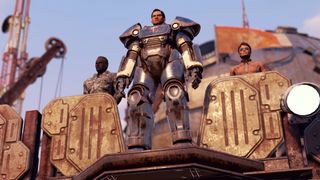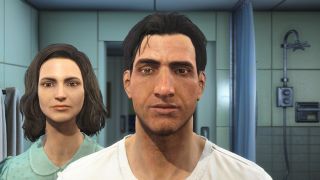So Starfield's still going to be really buggy, right?
Starfield's getting some extra development time, but will that be enough to avoid a typical Bethesda launch?

If there's two things I know to be true in this world, it's that you can't make a Tomlette without breaking some Gregs, and you can't launch a Bethesda RPG without some pretty big bugs. That's just science. But I've seen a bit of hopeful speculation that Starfield's new release date, September 6, could point to a precedent-breaker. Starfield was meant to be out last year, then pushed to the nebulous first half of 2023. September misses that window by three months, so some optimistic folks have reasoned that perhaps Microsoft's influence is at work here. With its new deep-pocketed publisher, could Bethesda be polishing Starfield far past the point of its previous games?

Starfield factions: Find a cause to quest for
Starfield cities: See the big spaces in space
Starfield companions: Collect cosmic comrades
Starfield traits: Give your hero some history
Starfield ship customization: Make your spaceship special
That's one interpretation. The other is that Starfield is still in rough shape and needs all the time it can get. That seems like a plausible outcome of Bethesda's ambition with Starfield: it's the first game to be made with its new "Creation Engine 2." It includes companions, outpost building, ship combat and customization, and more than 1,000 planets. That's a whole lot to pull off well, and it's not everything Bethesda's planning.
So the stakes are high, and our first look at a planet during Starfield's grand gameplay debut was pretty drab, and the framerate regularly dipped below a steady 30 fps. It's also the first RPG Bethesda has delayed since Oblivion in 2006.
Is another year of development since that initial delay likely to result in stable performance at launch? Could the Creation Engine 2 have been built to squash decades-old bugs? Maybe! But a look back at Bethesda's last 15+ years of games makes me think the pattern is too strong: Starfield's still going to be a Bethesda game through and through. Would we even recognize it without some bugs?
Fallout 76

Announced: May 30, 2018 | Released: November 14, 2018 | Delayed: No
What went wrong?
- Lots of bugs, bad AI, and broken animations
- Loads of missing features, like an FOV slider, had to be patched in later
- You couldn't carry or store much, not great for a game about collecting junk
The trouble started with the beta in October, which was so broken many players couldn't even get in and spent so much time re-downloading the build that they missed the window entirely. But that's a beta, and problems are expected. Surely the full launch went more smoothly, right?
The biggest gaming news, reviews and hardware deals
Keep up to date with the most important stories and the best deals, as picked by the PC Gamer team.
Not really. There were plenty of bugs at launch, like missing quest markers, bad enemy pathfinding, broken animations, AI misfires, and more. Beyond bugs there were lots of basic options missing, like toggles to turn off motion blur or Vsync and the ability to completely remap keyboard controls. Also missing: an FOV slider, a push-to-talk option, and text chat. There wasn't even a brightness slider! And the game was locked to 63 fps due to framerates being tied to physics speed, though this was finally patched (along with almost everything else listed above) and the fps cap was removed.
You couldn't carry much loot or store much in your cache, which was frustrating in a game where you spent most of your time collecting scrap. Plus, sharing the world with other players sometimes caused other problems, like when a quest-related ghoul you'd be looking for would be dead when you found him, killed by someone else on the server. Meaning you had to hop to another server until you found a version of the ghoul that was still alive so you could kill him yourself. Fallout 76 was probably the roughest shape a Bethesda game has been in at launch.
Fallout 4

Announced: June 3, 2015 | Released: November 10, 2015 | Delayed: No
What went wrong?
- Bethesda's aging engine drew a lot of flak for ugly graphics, even if sticking with the engine was the sensible choice
- A general sense that the bugs, performance issues, and few significant design changes from Fallout 3 made Fallout 4 a bit too samey
Bethesda pulled off an impressive move with Fallout 4, announcing it just five five months before release. It worked out better for Fallout 4 than the online Fallout 76, but Fallout 4 certainly wasn't bug-free. In April, five months after launch, modders put out the first version of the Unofficial Fallout 4 patch, but even it couldn't solve everything. Bethesda was quick to put out bug-squashing patches of its own, but the bigger conversation around Fallout 4 was about the overall fit and finish of Bethesda's engine. It looked and felt pretty rickety, with performance issues that players may not tolerate in Starfield in 2023.
Skyrim

Announced: December 11, 2010 | Released: November 11, 2011 | Delayed: No
What went wrong?
- Notorious memory issues made the PS3 port virtually unplayable for unlucky players for a few months
- A patch to fix other bugs caused dragons to start flying backwards
- You know it's bad when over two million players download a massive, community-made bug patch
Skyrim was the game that broke Bethesda out of "popular RPG" territory and moved the studio into "worldwide event" territory. It was a massive hit. Still, one reason it became such a successful platform for mods was because there were so many things modders could improve. An early one was the UI that was clearly designed for consoles rather than PC.
"We got a review copy of Skyrim the day the game was officially finished, but it's curiously buggy," we wrote in our 2011 review. "Among a lot of minor problems such as issues reassigning controls, there's glitchy character behaviour that can break quests, and AI flipouts that can turn a whole town against you. [...] There's a hell of a lot to patch here." Ah, more innocent times.
Fallout 3

Announced: July 12, 2004 | Released: October 28, 2008 | Delayed: No
What went wrong?
- Like the other games Bethesda made with the Gamebryo engine, savegame corruption was a problem
- Sure did love to crash, especially when you entered buildings
- New physics meant new physics glitches
The first Bethesda RPG to let you throw mini-nukes around introduced us to a new physics glitch: the one where dead bodies spin around with their limbs stretched thin and bent at weird angles. Sometimes it'll even happen to living NPCs. A separate glitch related to the physics engine occasionally launches a deathclaw or protectron into the sky. If you've ever seen a mammoth flying in Skyrim, that's the same bug persisting.
Via the Fallout wiki, here is a short list of circumstances in which Fallout 3 may crash or freeze:
- When using V.A.T.S.
- In Shalebridge hill when attempting to pick up any of the 5.56mm ammunition magazines in the Ant Queen's chamber.
- When receiving the Pip-Boy 3000.
- When convincing Moira Brown that the Wasteland Survival Guide will end up like her other projects while working on a subject in the second act.
- When skipping non-player character dialogue by clicking through.
- When bringing up the Pip-Boy.
- When attempting to talk to Burke for the first time.
- When starting a new game.
- When exiting the game.
- When entering, leaving, or even near Silver's house.
- When entering Rivet City's Upper Deck.
- When entering a new area of The Pitt.
- When repairing many items in a row too quickly.
- When entering or around Tenpenny Tower.
- When listening to the alien signal at the beginning of Mothership Zeta.
- When speaking to young boys in certain game files.
- When attempting to load or continue a game. There is no known fix for this.
Oblivion

Announced: May 18, 2005 | Released: March 20, 2006 | Delayed: Yes, by four months
What went wrong?
- So many bugs, so much crashing
- Savegame corruption
- Stuttering, both due to loading and a weird quirk of its audio
The NetImmerse Engine used on Morrowind evolved into Gamebryo in time for Oblivion, and brought with it bugs that would persist even into Bethesda's own Creation Engine, which was built on it. The most notable is its hatred of autosaves and quicksaves, which could easily become corrupted.
(In a savage bit of irony, Morrowind would crash if you saved too often or not enough. Due to a bug in the way it sorted data, if you didn't save for a while sometimes a buffer would overflow, the engine wouldn't find whatever data it was looking for, and it would crash. Meanwhile, if you kept too many savegames you'd start to get fatal load errors. The way around that was to keep a relatively small number of save files and keep saving over them. While hoping they don't get corrupted, of course.)
Oblivion launched with plenty of other bugs, including an animation bug so bad players nicknamed it the "Abomb." It only affected saves once you'd racked up around 200 hours of playtime, though that's not too hard for the dedicated Oblivion player. Abomb made animated objects slow or freeze, including doors, which then couldn't be opened. It's still a problem today, and you'll need to download a mod from 2006 to fix it.
There was also the issue of stuttering, which many put down to the size of the game's open world and its need to load in new assets as you crossed it. And while that's definitely part of the problem, even on a modern rig you may still experience stuttering in Oblivion. Turns out that Oblivion uses codecs when it's playing both Bink videos, like its intro, as well as music and background sounds in-game. If you've got a codec installed it doesn't like, it'll stutter.

Wes has been covering games and hardware for more than 10 years, first at tech sites like The Wirecutter and Tested before joining the PC Gamer team in 2014. Wes plays a little bit of everything, but he'll always jump at the chance to cover emulation and Japanese games.
When he's not obsessively optimizing and re-optimizing a tangle of conveyor belts in Satisfactory (it's really becoming a problem), he's probably playing a 20-year-old Final Fantasy or some opaque ASCII roguelike. With a focus on writing and editing features, he seeks out personal stories and in-depth histories from the corners of PC gaming and its niche communities. 50% pizza by volume (deep dish, to be specific).
Most Popular

